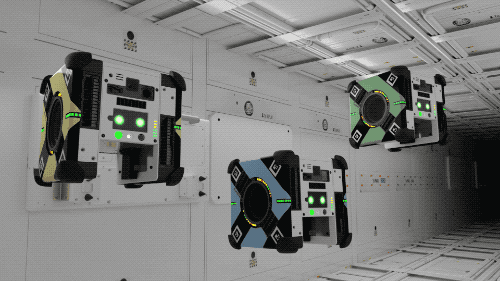Return to Gemini Program overview
Gemini XI
Richard Gordon (L) and Pete Conrad (R) Photo credit: NASA
liftoff to rendezvous in less than two hours
Command Pilot Pete Conrad and Richard Gordon achieved a number of firsts for NASA's Gemini program. Setting their first record just 94 minutes after liftoff, the Gemini XI crew rendezvoused with their Agena probe before completing their first orbit. To simulate the launch and rendezvous required of Apollo's Lunar Module and Command and Service Module (CSM) after a lunar landing, Conrad and Gordon reached the Agena with limited aid from ground controllers in what is known as a Direct-Ascent Rendezvous.
Richard Gordon straddling the Agena probe. Photo credit: NASA/Pete Conrad
Once docked and in a stable orbit, Richard Gordon began his first of two scheduled EVAs. With relative ease, Gordon attached a movie camera to the spacecraft and retrieved a micrometeorite experiment from an external panel. His next task called for him to attach one end of a 30 meter tether stored on the Agena to the Gemini capsule's docking bar. This task proved more difficult. Gordon completed managed to attach the tether, but not before working himself into exhaustion.
Overexerting his life support system, Gordon found himself experiencing working conditions similar to those of Gene Cernan's EVA on Gemini IX-A. His co-pilot's safety in mind, Conrad decided to cancel a power tool evaluation experiment and ordered Gordon back into the spacecraft; cutting his scheduled 107 minutes down to only 33.
GEMINI XI REACHED THE HIGHEST operational orbit in history
After the two were given time to rest, a burn from the Agena's engines increased the orbital apogee of the combined spacecraft to 1,370 km (850 miles). And, while the Apollo missions did take astronauts much farther, not even NASA's future Space Shuttle program would bring humans to a higher operational orbit than that of Gemini XI.
Gemini XI kept this apogee for two full orbits; during which time Gordon and Conrad were able to complete a nuclear emulsion experiment to measure radiation levels at the highest manned altitudes ever recorded. Another burn from Agena's engines brought their orbit down to a near-circular 296 km (184 miles).
THE LONGEST EVA OF ALL THE GEMINI MISSIONS
Refreshed and recuperated from the fatigue of his first EVA the day prior, Gordon's second EVA began at 7:49am ET, September 14. A stand-up EVA only, exhaustion wasn't a concern for Gordon as he completed a number of photography experiments over the course of 108 minutes. Gordon's second EVA complete, the Gemini XI crew undocked and began to slowly move away from the Agena, pulling taught the 30 meter tether still connecting the two spacecraft.
The first time artificial gravity is created in space
The passive attitude stabilization experiment, designed to simulate gravity in outer space, called for Conrad to initiate a rotation between the connected vessels. Using small bursts of their maneuvering thrusters, slows rotations of the Gemini capsule around the Agena were accomplished for brief periods. Despite difficulties in initiating the spin, the experiment was ultimately successful. Though minuscule in scale, Gemini XI managed to simulate 0.00015x Earth's gravity.
Detached permanently following the passive attitude stabilization experiment, the Gemini capsule docked and undocked with the Agena probe a total of five times before mission's end. Bidding the probe farewell, Pete Conrad and Richard Gordon initiated Gemini's retrofire burn during their 44th orbit, at 8:24am ET, September 15.
Another first for Gemini XI, Conrad and Gordon relied on automated computer commands to control the craft's reentry thrusters during its descent through Earth's atmosphere. A relatively accurate system, the Gemini XI capsule splashed down just 4.9 km from their target in the western Atlantic Ocean at 8:59am ET.
Gemini XI press kit










